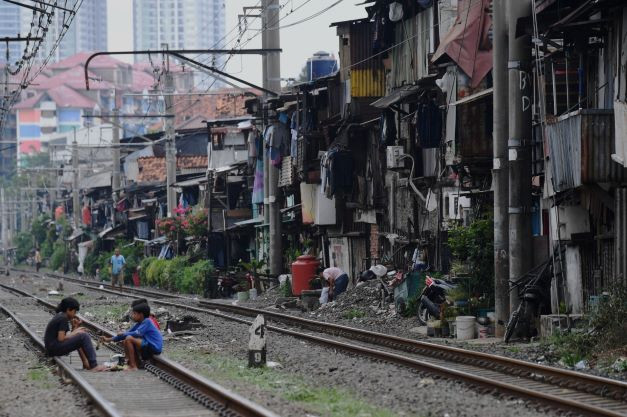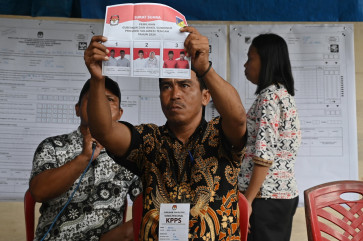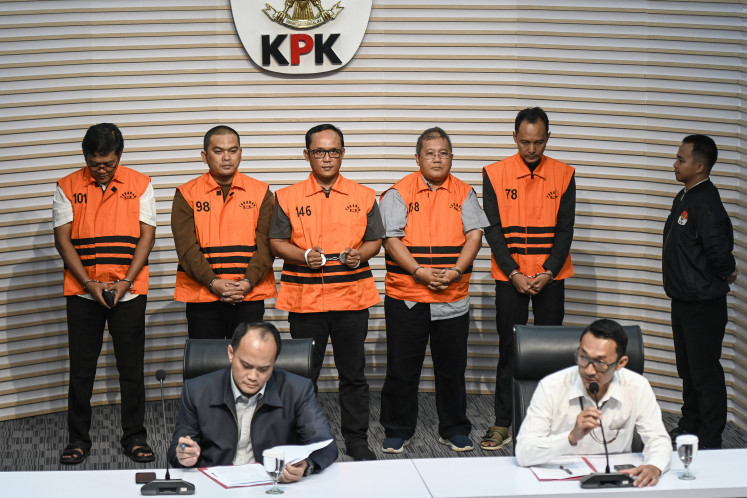Popular Reads
Top Results
Can't find what you're looking for?
View all search resultsPopular Reads
Top Results
Can't find what you're looking for?
View all search resultsToo early to celebrate
Relying on social safety nets will not do much as this only provides short-term relief, while more often such programs coincide with a populist agenda of incumbents seeking to stay in power. There have been many reports of social assistance that went to those who did not deserve the aid.
Change text size
Gift Premium Articles
to Anyone
 On the right track: Children defy the heat as they play on the rail tracks in Pejompongan, Central Jakarta, on July 15, 2022. Statistics Indonesia (BPS) found the country’s poor population declined by 1.38 million, or 0.6 percent month-to-month, to 26.16 million in March. (Antara/Hafidz Mubarak Ahmad)
On the right track: Children defy the heat as they play on the rail tracks in Pejompongan, Central Jakarta, on July 15, 2022. Statistics Indonesia (BPS) found the country’s poor population declined by 1.38 million, or 0.6 percent month-to-month, to 26.16 million in March. (Antara/Hafidz Mubarak Ahmad)
I
t would be unwise to assume that the decline in the poverty rate in Indonesia, which reached a historic low of 9.03 percent in March according to Statistics Indonesia (BPS), is indicative of a major improvement in the country's socioeconomic front.
The percentage means over 25 million Indonesians are classified as poor, which is measured by their spending being less than Rp 582,932 (US$35.81) per capita per month.
We have reasons to remain unsatisfied with the so-called achievement, given that the government’s five-year long-term development plan (RPJMN) for 2019-2024 set a target of curbing the poverty rate to 6 to 7 percent.
The government could say that the pandemic is to blame for its failure to meet the target, but it didn't do much better in the poverty reduction programs in the previous five years, when there were fewer economic shocks. Back then, Indonesia’s poverty rate was 9.22 percent based on BPS’ September 2019 survey, which was well below the target of between 7 and 8 percent.
We agree with experts who attribute the sluggish progress in poverty alleviation to the massive distribution of social assistance, particularly in the form of cash pay-outs and staple food disbursements, instead of an improvement of human resources through better access to higher education and re-skilling that would have helped lower-income people obtain decent jobs and climb up the socioeconomic ladder.
Relying on social safety nets will not do much as this only provides short-term relief, while more often such programs coincide with a populist agenda of incumbents seeking to stay in power. There have been many reports of social assistance that went to those who did not deserve the aid.
In the next long-term development plan from 2024 to 2029, the poverty rate reduction is set even lower at 4.5 to 5 percent, which must be more difficult to achieve unless radical changes are made during the incoming administration of president-elect Prabowo Subianto.
Besides, the measurement of poverty is not as straightforward as establishing a specific spending threshold to determine the number of individuals unable to meet their basic needs.
There is no right or wrong way to measure poverty, but the metrics to focus on capture different things. Experts have long suggested that poverty has many layers and should include access to education, health care, housing, clean water and sanitation, among others metrics.
It is undeniable that many people, even if they are not classified as poor using the BPS threshold, are deprived of those amenities. Let alone those living below the threshold, which implies their hardship can be worse than simply being unable to afford basic needs.
This too will likely be overlooked given the government’s approach to handling poverty.
Furthermore, we need to take into account the fact that Indonesia’s poverty threshold is deemed too low for an upper-middle income country, a status it received for its 2022 economic performance.
The World Bank, for instance, has recommended an upper-middle income country use $6.85 purchasing power parity (PPP) to measure its poverty line.
The SMERU research institute has found that our poverty line is set at $3.16 PPP. By comparison, the standard for low-income countries is $2.15 PPP, while for lower-middle income countries it is $3.65 PPP.
At the end, it is still too early to call the new poverty rate a success. At this rate, it remains to be seen whether we can meet the Golden Indonesia 2045 vision, which projects the poverty rate to plunge to around 0.8 percent.
The government has said that by then Indonesia will emerge as a high-income country by World Bank standards. This is a tall order as it requires Indonesia to grow at least 7 percent on average annually, while we have managed only 5 percent over the past decade.










